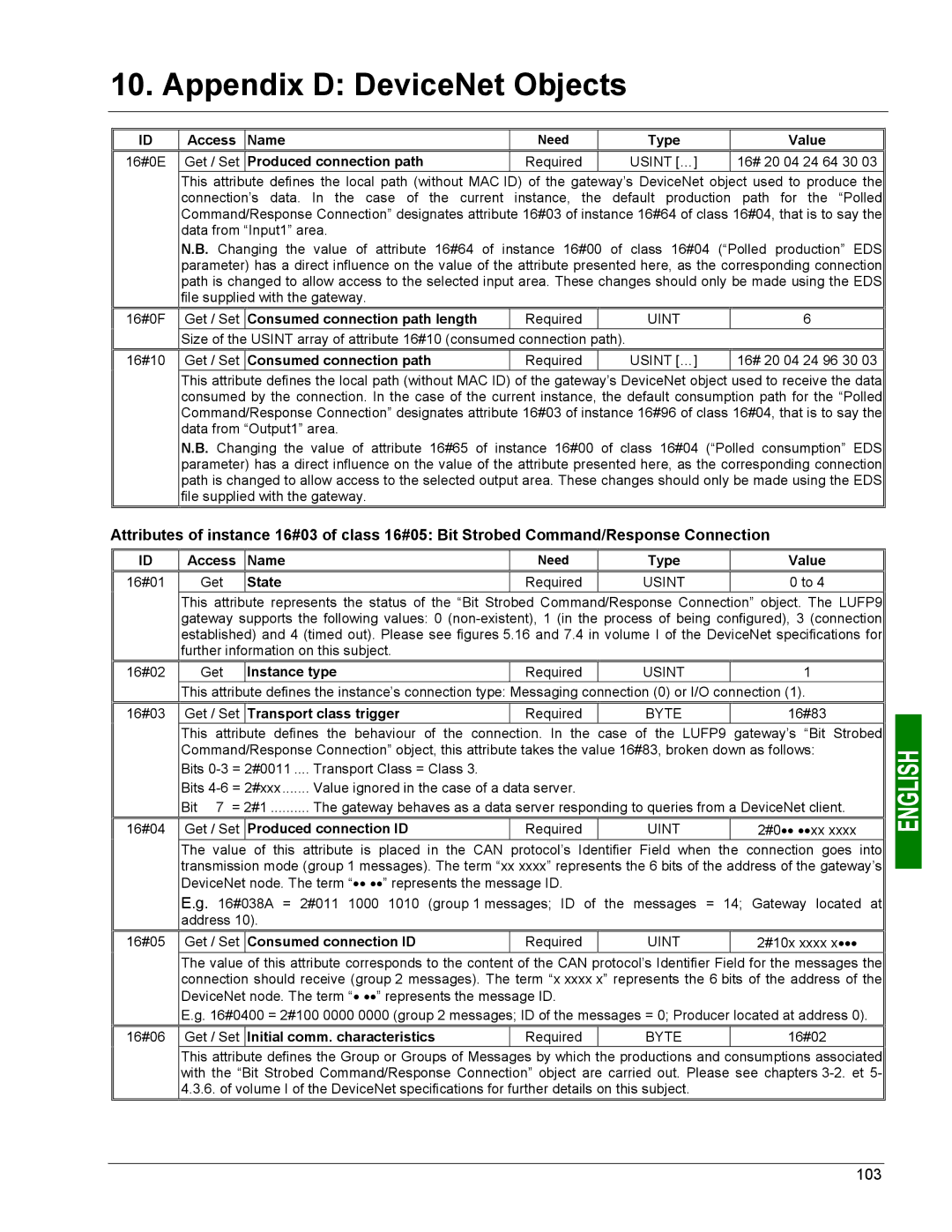
10. Appendix D: DeviceNet Objects
ID | Access | Name | Need | Type | Value |
16#0E | Get / Set | Produced connection path | Required | USINT […] | 16# 20 04 24 64 30 03 |
This attribute defines the local path (without MAC ID) of the gateway’s DeviceNet object used to produce the connection’s data. In the case of the current instance, the default production path for the “Polled Command/Response Connection” designates attribute 16#03 of instance 16#64 of class 16#04, that is to say the data from “Input1” area.
N.B. Changing the value of attribute 16#64 of instance 16#00 of class 16#04 (“Polled production” EDS parameter) has a direct influence on the value of the attribute presented here, as the corresponding connection path is changed to allow access to the selected input area. These changes should only be made using the EDS file supplied with the gateway.
16#0F
Get / Set | Consumed connection path length | Required | UINT | 6 |
Size of the USINT array of attribute 16#10 (consumed connection path).
16#10
Get / Set | Consumed connection path | Required | USINT […] | 16# 20 04 24 96 30 03 |
This attribute defines the local path (without MAC ID) of the gateway’s DeviceNet object used to receive the data consumed by the connection. In the case of the current instance, the default consumption path for the “Polled Command/Response Connection” designates attribute 16#03 of instance 16#96 of class 16#04, that is to say the data from “Output1” area.
N.B. Changing the value of attribute 16#65 of instance 16#00 of class 16#04 (“Polled consumption” EDS parameter) has a direct influence on the value of the attribute presented here, as the corresponding connection path is changed to allow access to the selected output area. These changes should only be made using the EDS file supplied with the gateway.
Attributes of instance 16#03 of class 16#05: Bit Strobed Command/Response Connection
ID | Access | Name | Need | Type | Value |
16#01 | Get | State | Required | USINT | 0 to 4 |
This attribute represents the status of the “Bit Strobed Command/Response Connection” object. The LUFP9 gateway supports the following values: 0
16#02
Get | Instance type | Required | USINT | 1 |
This attribute defines the instance’s connection type: Messaging connection (0) or I/O connection (1).
16#03
Get / Set | Transport class trigger | Required | BYTE | 16#83 |
This attribute defines the behaviour of the connection. In the case of the LUFP9 gateway’s “Bit Strobed Command/Response Connection” object, this attribute takes the value 16#83, broken down as follows:
Bits | = 2#0011 .... | Transport Class = Class 3. |
Bits | = 2#xxx | Value ignored in the case of a data server. |
Bit 7 | = 2#1 | The gateway behaves as a data server responding to queries from a DeviceNet client. |
16#04
Get / Set | Produced connection ID | Required | UINT | 2#0•• ••xx xxxx |
The value of this attribute is placed in the CAN protocol’s Identifier Field when the connection goes into transmission mode (group 1 messages). The term “xx xxxx” represents the 6 bits of the address of the gateway’s DeviceNet node. The term “•• ••” represents the message ID.
E.g. 16#038A = 2#011 1000 1010 (group 1 messages; ID of the messages = 14; Gateway located at address 10).
16#05
Get / Set | Consumed connection ID | Required | UINT | 2#10x xxxx x••• |
The value of this attribute corresponds to the content of the CAN protocol’s Identifier Field for the messages the connection should receive (group 2 messages). The term “x xxxx x” represents the 6 bits of the address of the DeviceNet node. The term “• ••” represents the message ID.
E.g. 16#0400 = 2#100 0000 0000 (group 2 messages; ID of the messages = 0; Producer located at address 0).
16#06
Get / Set | Initial comm. characteristics | Required | BYTE | 16#02 |
This attribute defines the Group or Groups of Messages by which the productions and consumptions associated with the “Bit Strobed Command/Response Connection” object are carried out. Please see chapters
103
